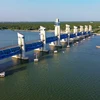Vietnam will work to improve the resistance of its marine ecosystems to climate change impacts while maintaining their productivity, policy makers said on April 2.
The "Strategy for Sustainable Exploitation and Utilisation of Marine Natural Resources and Environment Protection until 2020, vision towards 2030," was officially released by the Ministry of Natural Resources and Environment.
It targets, by 2020, to increase the area of mangrove forests in coastal areas and around islands by 30 percent higher than 2010, according to Nguyen Van Tai, director of the ministry's Institute of Strategy and Policy.
The area of mangroves has reduced drastically to over 15,000ha in the Cuu Long (Mekong) Delta. From 1943-1955, the area was 154,000ha.
The strategy also targets that the area, size and quality of coral reefs in the country in 2010 are maintained by 2020. It is estimated that just16,000ha, accounting for 14.5 percent of total coral reef area, are in good condition now.
Another target is not to have the number of aquatic species threatened with extinction to increase compared with 2010, levels.
The ministry has listed 37 species of marine fish, five species of shrimp, 27 species of mollusks and three species of Cephalopoda as precious and rare, endangered and facing the threat of extinction.
Sardines (Clupanodon thrissa) and abalone (Haliotis diversicolor) are among the endangered species inhabiting coral reefs off the islands of Bach Long Vi, Cat Ba, and Co To.
Deputy Minister of Natural Resources and the Environment Tran Hong Ha said that the strategy also aimed to compile a more comprehensive database of the nation's seas and marine diversity, and reduce the rate of resource degradation and pollution of the marine environment.
He said the new targets followed up on the discovery and realisation that the nation faces several marine resources management issues including unsustainable exploitation that has severely depleted and degraded them.
Marine biodiversity had been badly affected, as also ecological functions and biological productivity of marine ecosystems, he said, adding that a downward trend had been seen in water quality.
Tai said six measures had been identified to effectively implement the new national strategy, including: raising public awareness of sustainable use of marine resources; consistent management of marine resources and environment by relevant institutions; and training human resources to better manage the nation's marine resources and marine environment.
Vietnam lies to the west of the East Sea and touches the sea in three directions, with a long coastline of over 3,200km and territorial sea of more than 1 million square kilometres, which is triple the area of its mainland.-VNA
The "Strategy for Sustainable Exploitation and Utilisation of Marine Natural Resources and Environment Protection until 2020, vision towards 2030," was officially released by the Ministry of Natural Resources and Environment.
It targets, by 2020, to increase the area of mangrove forests in coastal areas and around islands by 30 percent higher than 2010, according to Nguyen Van Tai, director of the ministry's Institute of Strategy and Policy.
The area of mangroves has reduced drastically to over 15,000ha in the Cuu Long (Mekong) Delta. From 1943-1955, the area was 154,000ha.
The strategy also targets that the area, size and quality of coral reefs in the country in 2010 are maintained by 2020. It is estimated that just16,000ha, accounting for 14.5 percent of total coral reef area, are in good condition now.
Another target is not to have the number of aquatic species threatened with extinction to increase compared with 2010, levels.
The ministry has listed 37 species of marine fish, five species of shrimp, 27 species of mollusks and three species of Cephalopoda as precious and rare, endangered and facing the threat of extinction.
Sardines (Clupanodon thrissa) and abalone (Haliotis diversicolor) are among the endangered species inhabiting coral reefs off the islands of Bach Long Vi, Cat Ba, and Co To.
Deputy Minister of Natural Resources and the Environment Tran Hong Ha said that the strategy also aimed to compile a more comprehensive database of the nation's seas and marine diversity, and reduce the rate of resource degradation and pollution of the marine environment.
He said the new targets followed up on the discovery and realisation that the nation faces several marine resources management issues including unsustainable exploitation that has severely depleted and degraded them.
Marine biodiversity had been badly affected, as also ecological functions and biological productivity of marine ecosystems, he said, adding that a downward trend had been seen in water quality.
Tai said six measures had been identified to effectively implement the new national strategy, including: raising public awareness of sustainable use of marine resources; consistent management of marine resources and environment by relevant institutions; and training human resources to better manage the nation's marine resources and marine environment.
Vietnam lies to the west of the East Sea and touches the sea in three directions, with a long coastline of over 3,200km and territorial sea of more than 1 million square kilometres, which is triple the area of its mainland.-VNA



















